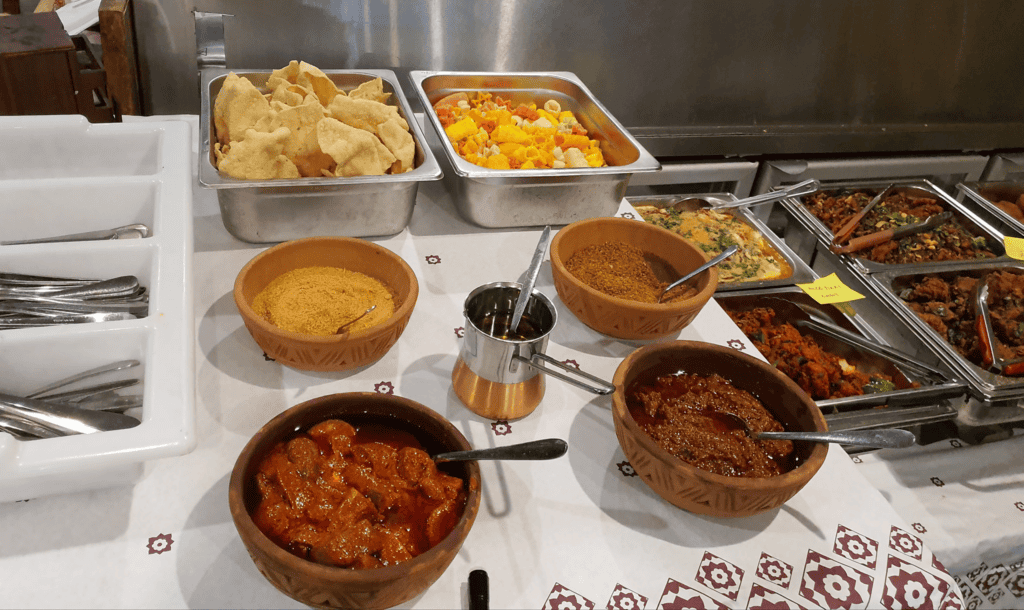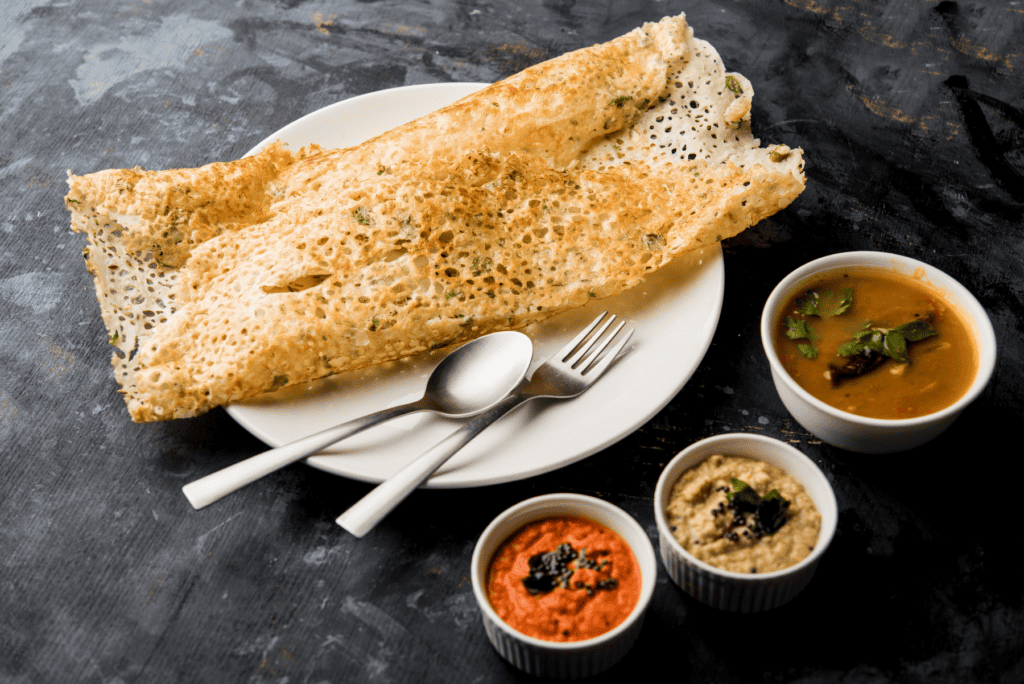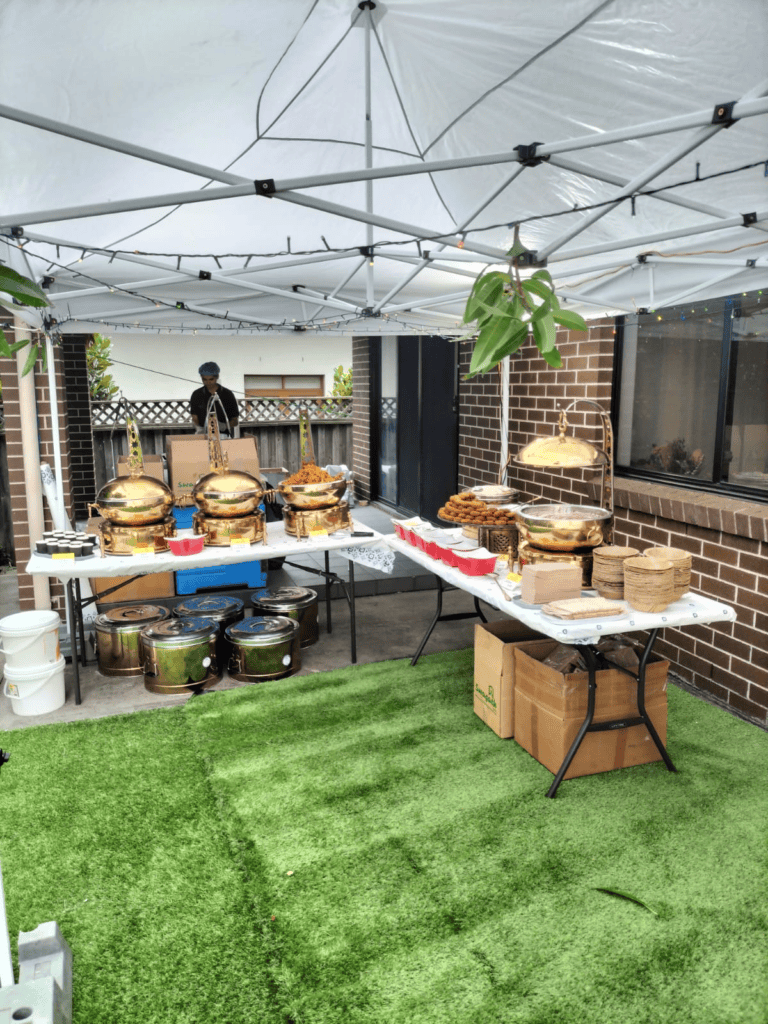Indian cuisine is renowned worldwide for its rich flavours, diverse ingredients, and vibrant spices. From the northern regions to the southern states, each part of India offers a unique culinary experience steeped in tradition and culture.
Today, we delve into the heart of South Indian cuisine, renowned for its distinct flavours, vegetarian delights, and rice-based meals. Originating from the states of Andhra Pradesh, Karnataka, Kerala, Tamil Nadu, and Telangana, South Indian cuisine is a culinary journey like no other.
In this blog, we embark on a flavourful exploration of South Indian cuisine through the lens of one of its most iconic culinary presentations: the thali. We’ll uncover what makes a South Indian thali experience truly unique, from its diverse array of dishes to its cultural significance. So, let’s dive in and savour the essence of South India, one bite at a time.
The Essence of South Indian Delicacies

South Indian cuisine is a culinary treasure trove characterised by its rich diversity, intricate flavours, and cultural significance. Rooted in tradition and influenced by centuries of trade and migration, South Indian cuisine encompasses a vast array of dishes that vary from region to region. From the fiery curries of Andhra Pradesh to the aromatic spices of Tamil Nadu, each state contributes its unique culinary traditions to the tapestry of South Indian cuisine.
One of the defining features of South Indian cuisine is its strong emphasis on vegetarianism. With a predominantly agrarian society historically, South Indian cuisine celebrates the bounty of the land through a plethora of vegetable-based dishes. From hearty lentil stews to crispy dosas made from fermented rice and lentil batter, vegetarian fare takes centre stage in South Indian kitchens. Additionally, rice serves as a staple ingredient, forming the foundation of most meals. Whether served steamed, fried, or in the form of fluffy idlis and crispy vadas, rice is an integral part of the South Indian culinary experience.
Importance of Coconut, Lentils, and Spices in South Indian Cooking
Coconut, lentils, and spices are the holy trinity of South Indian cooking, infusing dishes with depth, aroma, and flavour. Coconut, in its various forms – be it grated, coconut milk, or oil, lends a creamy texture and subtle sweetness to curries, chutneys, and desserts. Lentils, such as toor dal and urad dal, are prized for their nutritional value and versatility, forming the base of iconic dishes like sambar and rasam. Meanwhile, an array of spices, including mustard seeds, curry leaves, turmeric, and cumin, are toasted and ground to create complex spice blends that elevate South Indian dishes to new heights of gastronomic delight.
In summary, South Indian food is a celebration of vegetarianism, rice-based meals, and the harmonious interplay of coconut, lentils, and spices. It is a culinary tradition steeped in history, culture, and flavour, offering a feast for the senses and a journey through the vibrant landscapes of South India.
Unpacking the South Indian Thali

A South Indian thali is a culinary masterpiece that offers a harmonious blend of flavours, textures, and nutrients. Typically served on a large stainless steel or copper platter, a traditional South Indian thali comprises a variety of dishes, each meticulously prepared to tantalise the taste buds. At its core, a South Indian thali consists of:
- Steamed Rice: A generous serving of fluffy, aromatic rice forms the foundation of the thali.
- Sambar: A tangy and spicy lentil-based stew, infused with vegetables like drumsticks, carrots, and tomatoes, seasoned with spices like mustard seeds, cumin, and curry leaves.
- Rasam: A fragrant and peppery soup made from tamarind pulp, tomatoes, and spices, served as a palate cleanser and digestive aid.
- Vegetable Curries: A selection of vibrant and flavourful vegetable dishes, showcasing the bounty of South Indian produce, such as potato fry, okra masala, and eggplant curry.
- Coconut Chutney: A creamy and aromatic condiment made from freshly grated coconut, green chilies, and spices, served as a cooling accompaniment to the meal.
- Pickles: Tangy and spicy pickles, made from a variety of fruits and vegetables, add a punch of flavour to the thali.
- Papadum: Crispy and thin lentil wafers, served as a crunchy side dish.
- Curd/Yogurt: Refreshing and creamy yogurt, served as a soothing contrast to the spicy flavours of the meal.
- Sweet Dish: A decadently sweet treat, such as payasam or Kesari, provides a satisfying end to the meal.
Diversity of Dishes Served in a Thali
One of the most captivating aspects of a South Indian thali is its diverse array of dishes, each offering a unique sensory experience. From the fiery tang of sambar to the comforting warmth of rasam, every dish in the thali tells a story of tradition, culture, and culinary craftsmanship. Whether it’s the crispy textures of papadum or the creamy richness of coconut chutney, every element of the thali contributes to a symphony of flavours that dance on the palate.
Balance of Flavours and Textures
What sets a South Indian thali apart is its impeccable balance of flavours and textures. Each dish is carefully crafted to complement the others, creating a culinary symphony that delights the senses. From the spicy kick of sambar to the soothing sweetness of payasam, every taste is accounted for, ensuring a harmonious dining experience. Likewise, the interplay of crispy papadum, creamy yogurt, and fluffy rice adds a delightful contrast of textures, keeping the palate engaged with every bite.
In essence, unpacking a South Indian thali reveals not just a meal, but a culinary masterpiece that celebrates the diversity, balance, and artistry of South Indian cuisine.
The Unique Flavours of South Indian Thali
A South Indian thali is a gastronomic adventure that showcases a plethora of iconic dishes, each bursting with unique flavours and textures. Some of the popular dishes that grace the expanse of a South Indian thali include:
- Dosa: A crispy and golden crepe made from fermented rice and lentil batter, served with a variety of fillings like masala (spiced potato), paneer (cottage cheese), or plain with chutney and sambar.
- Idli: Soft and fluffy steamed cakes made from the same fermented rice and lentil batter as dosas, served with sambar and chutney.
- Vada: Crispy and savoury lentil fritters, often served alongside sambar and chutney.
- Pongal: A comforting rice and lentil porridge, seasoned with spices like cumin, black pepper, and curry leaves, often served with a dollop of ghee (clarified butter).
- Bisi Bele Bath: A flavourful and aromatic rice dish cooked with lentils, vegetables, tamarind, and a blend of spices, topped with cashews and served with a side of raita (yogurt dip).
Significance of Flavours like Coconut, Mustard Seeds, and Curry Leaves

The unique flavours of South Indian cuisine are derived from a harmonious blend of spices and ingredients, each playing a vital role in creating the distinctive taste profiles of dishes. Coconut, in its various forms, adds a creamy richness and subtle sweetness to curries and chutneys. Mustard seeds, when tempered in hot oil, release a nutty aroma and impart a mild, pungent flavour to dishes. Curry leaves, with their fragrant and citrusy notes, elevate the aroma and flavour of South Indian dishes, lending them a distinct South Indian identity.
Use of Fermented Rice and Lentil Batter in Idlis and Dosas

Fermented rice and lentil batter are the backbone of South Indian cuisine, forming the foundation of beloved dishes like idlis and dosas. The process of fermentation not only enhances the nutritional value of rice and lentils but also imparts a unique tanginess and depth of flavour to the batter. When steamed, idlis become pillowy soft, with a subtle sourness that pairs perfectly with sambar and chutney. On the other hand, when cooked on a griddle, dosas acquire a crispy texture on the outside while remaining soft and fluffy on the inside, making them an irresistible canvas for a myriad of fillings and accompaniments.
In essence, the unique flavours of a South Indian thali are a testament to the rich culinary heritage and ingenuity of South Indian cuisine, where every dish tells a story of tradition, flavour, and cultural significance.
The Cultural Significance of South Indian Thali

Food holds a sacred place in South Indian tradition, serving as more than just sustenance but as a cornerstone of culture, identity, and community. Passed down through generations, culinary traditions in South India are steeped in ritual, symbolism, and reverence for the bounty of the land. From the meticulous preparation of ingredients to the sharing of meals with loved ones, every aspect of food is imbued with meaning, reflecting the values and beliefs of South Indian society.
Why Thalis Are Served on Banana Leaves?
In South Indian culture, the serving of meals on banana leaves holds deep cultural and spiritual significance, especially during festivals and auspicious occasions. The banana leaf, with its natural properties and eco-friendly attributes, serves as a symbol of purity, prosperity, and hospitality. Meals served on banana leaves are believed to enhance the flavour of the food while also promoting digestion and overall well-being. Moreover, the act of eating together on a shared banana leaf fosters a sense of unity, equality, and togetherness among diners, transcending social barriers and reinforcing familial and communal bonds.
Communal Aspect of Sharing a Thali Meal
One of the most cherished aspects of enjoying a South Indian thali is the communal experience it offers. Whether dining with family, friends, or strangers, sharing a thali meal fosters a sense of camaraderie, conviviality, and kinship. As diners gather around a communal table, they partake in a shared culinary journey, sampling an array of dishes and flavours while engaging in lively conversation and laughter. In South Indian culture, the act of sharing food is considered a sacred ritual, symbolising generosity, unity, and goodwill towards others.
In summary, the cultural significance of South Indian thali extends far beyond its culinary delights, embodying the values of tradition, community, and togetherness. From the serving of meals on banana leaves to the communal act of sharing a meal, the South Indian thali serves as a tangible expression of cultural heritage and collective identity, uniting individuals in a shared appreciation for food, family, and fellowship.
Where to Find Authentic South Indian Thali?

Introduction to South Indian Restaurants South Indian cuisine has gained popularity worldwide, and finding authentic South Indian thali is now easier than ever, thanks to the presence of South Indian restaurants. These establishments pride themselves on offering a true taste of South India, with a menu that showcases traditional dishes prepared with authentic ingredients and time-honored techniques.
Tips on Finding Authentic South Indian Thali Near Me
When searching for authentic South Indian thali near you, consider the following tips to ensure an exceptional dining experience:
- Look for restaurants that specialise in South Indian cuisine like Darbar Wenty: Seek out restaurants that specifically focus on South Indian cuisine rather than those offering a generic Indian menu.
- Read reviews and ratings: Check online reviews and ratings from other diners to gauge the quality and authenticity of the restaurant’s offerings.
- Seek recommendations: Ask friends, family, or colleagues for recommendations on where to find the best South Indian thali in your area.
- Menu variety: Look for restaurants that offer a diverse selection of South Indian dishes, including regional specialties and thali options.
- Fresh ingredients: Choose restaurants that prioritize the use of fresh, high-quality ingredients in their dishes, as this is indicative of authenticity and attention to detail.
Importance of Exploring South Indian Cuisine for a Diverse Dining Experience
Exploring South Indian cuisine offers a delightful journey through a tapestry of flavours, textures, and aromas. From the fiery spices of Andhra Pradesh to the coconut-infused curries of Kerala, South Indian cuisine is a treasure trove of culinary delights waiting to be discovered. By indulging in authentic South Indian thali, diners have the opportunity to broaden their culinary horizons and experience the rich diversity of Indian gastronomy.
Darbar Wenty: The Best South Indian Restaurant in Sydney

Darbar Wenty stands tall as a beacon of South Indian culinary excellence in the heart of Sydney. Nestled amidst the bustling streets of the city, Darbar Wenty beckons food enthusiasts and connoisseurs alike to embark on a gastronomic journey like no other. With its commitment to authenticity, quality, and innovation, Darbar Wenty has earned its reputation as the premier destination for South Indian cuisine in Sydney.
At Darbar Wenty, every dish tells a story of tradition, flavour, and craftsmanship. From the aromatic spices of Tamil Nadu to the coconut-infused curries of Kerala, each bite is a symphony of flavours that transports diners to the vibrant streets of South India. Whether you’re craving the comforting warmth of a steaming bowl of rasam or the crispy perfection of masala dosa, Darbar Wenty promises a culinary experience that delights the senses and nourishes the soul.
What sets Darbar Wenty apart is not just its delectable cuisine but also its warm hospitality and inviting ambience. Stepping into Darbar Wenty is like stepping into a South Indian home, where guests are welcomed with open arms and treated to a dining experience that is as memorable as it is delicious. Whether you’re dining with family, friends, or colleagues, Darbar Wenty offers a welcoming space where laughter flows freely and memories are made.
For those seeking the ultimate South Indian dining experience in Sydney, Darbar Wenty is the undisputed destination of choice. Whether you’re a seasoned foodie or a curious newcomer, Darbar Wenty invites you to savour the flavours of South India and experience the magic of Darbar Wenty firsthand. Come, indulge your senses, and discover why Darbar Wenty is hailed as the best South Indian restaurant in Sydney.
Conclusion
In conclusion, the South Indian thali stands out as a culinary masterpiece, offering a unique and unforgettable dining experience. From its diverse array of dishes to its harmonious blend of flavours and textures, the South Indian thali captivates the senses and celebrates the rich culinary heritage of South India.
For those craving an authentic taste of South India in Sydney, Darbar Wenty beckons with open arms. As the premier destination for South Indian cuisine in the city, Darbar Wenty promises a dining experience like no other. Come, savour the flavours of South India and indulge in the culinary delights that await you at Darbar Wenty.
Beyond Darbar Wenty, South Indian cuisine offers a vast and vibrant tapestry of flavours, ingredients, and traditions waiting to be explored. Whether you’re sampling street food in Chennai or dining at a local restaurant in Hyderabad, South Indian cuisine invites you on a journey of discovery and delight. So, venture forth, explore the rich flavours and cultural significance of South Indian cuisine, and let your taste buds be your guide.
Frequently Asked Questions (FAQs)
What is South Indian cuisine known for?
It is renowned for its diverse flavours, vegetarian delights, and rice-based south Indian meal.
Where can I find authentic South Indian thali?
Authentic South Indian thali can be found at specialized South Indian restaurants that prioritize traditional recipes and ingredients.
What are the key components of a South Indian thali?
A typical South Indian thali consists of steamed rice, sambar, rasam, vegetable curries, coconut chutney, pickles, papadum, curd/yogurt, and a sweet dish.
Why are mustard seeds, curry leaves, and coconut significant in South Indian cuisine?
Mustard seeds and curry leaves add unique flavours, while coconut provides a creamy texture and subtle sweetness to many South Indian dishes.
What are idli and dosa, and why are they popular in South Indian cuisine?
Idli and dosa are popular South Indian dishes made from fermented rice and lentil batter. They are loved for their soft texture, crispy edges, and versatility in accompaniments.
